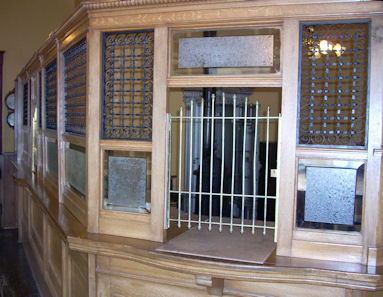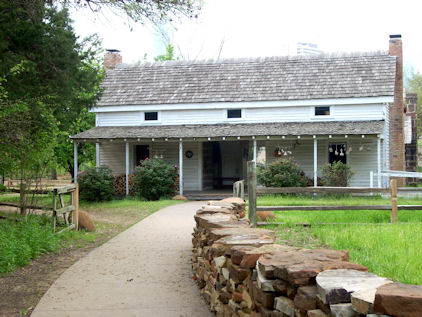Last episode I waxed poetic (as I so often do) about Dallas Heritage Village, which is located on the environs of the big D’s original city park — which is called, cleverly enough, Old City Park. The curators have collected and maintained 38 wonderful old buildings from all over North Texas, including a log cabin (and the mansion its owners subsequently moved into), barns, animal pens, a bank, a saloon, a law office, a print shop, et cetera. They’ve basically created a small North Texas village from the turn of the last century, and have included sweet little touches like a fountain, a clock on a column in front of the bank, benches, fences, and connecting streets to add to the verisimilitude and tie what could have been a jumble into a unified whole. There’s even a bandstand with a surrounding village green, shaded by majestic trees.
For much of the year, they even have costumed re-enactors wandering through and working on the grounds, interacting with the visitors. Think of it as Dallas’ little answer to Colonial Williamsburg, I guess. I could see film companies using this as a realistic frontier town, though of course they’d have to digitally remove the skyscrapers from the background. After all, downtown’s just a mile or so away.
Last time, I got no farther than the aforementioned mansion, Millermore. This time I’ll try to include a few more sights, though by no means everything; there were so many items to crow about that you’ll see only the things that most impressed me. That includes the animals, of course.
Oh, did I not mention them? There are several animal paddocks in the village, particularly over at the dog run house I mentioned in Part I (it also includes a small kitchen garden, which was still mostly fallow when I visited). Among other things there’s a small chicken coop, mostly for egg production, and of course there were a few sheep out and about, too, as you can see.

I expect they’d have kept a few cattle, if there’d been room. Actually there was, but they needed it for the donkeys, who live in a pen on the opposite corner of the Village, next to the 1910-era doctor’s office.

These nice, quiet fellows are for more than just show; they actually have the job of pulling around a wagon that Miss Clementine, one of the re-enactor characters, rides around the Village. Now, when my friend Tammy kept telling me about the donkeys, I expected the normal small kind that have a black stripe across the shoulders. I guess those are burros, really. When I saw these guys, I was sure they were mules because they were so large, a belief I wasn’t disabused of until I did some online research. In fact, they’re a breed of donkey called Mammoth Jack, which was apparently bred specifically for pulling wagons. They’re supposed to be the second largest breed of donkey, which makes me wonder just how big the largest breed is. Clydesdale-sized, maybe?
But back to the buildings. Most of these structures you could go into, and get a feel for how they were used back in the day. Generally, they include period props — for example, McGuffey readers in the schoolhouse, and lovely old-fashioned china and period furniture in the homes. For example, here’s Citizen’s Bank (originally from Justin, Texas), with a view inside:


If you’ll look carefully, you’ll see a potbellied wood-burning stove behind the teller’s window, complete with a stovepipe that goes up through the roof.
Right next door was the print shop, the side of which was decorated with this bit of Americana, back when they advertised soft drinks as being good for you. Dr. Pepper was, of course, heavily touted around here, since it was invented in Texas and there was, for years, a huge Dr. Pepper bottling plant in Dallas.

Here’s a view of the inside of the print shop, which is set up more as an interpretive center than as an actual accurate museum piece — hence the big posters on the walls. That great big machine with the keyboard on the left, with the chair next to it, is a linotype machine. That’s how they created and set up print for papers and books before computer layout and typesetting was invented. The type was printed out on a strip, and then literally cut and pasted into columns on the page. That’s why sometimes, in old books, you’ll see a line that appears to have slipped a little sideways, or is crooked; and it also explains why, occasionally, whole lines get put in the wrong order. Screw-ups still happen with computer layout, of course, but they’re different kinds of screw-ups.
In addition to commercial and public buildings, Dallas Heritage Village also includes numerous private structures — which is to say, people’s houses. I’ve already shown you Millermore and the old Miller cabin, and I’ve mentioned the dog-run house a couple of times. Here’s what the latter looks like from the front. You can see the gap between the two sides of the house, if you look closely.

Two of the other homes that I found particularly fetching were the Brent Place (which is located next to the historic location of Browder Springs) and the Blum House. The uppermost picture below is of the Brent House; the bottom one is the Blum home. Incidentally, this is the same Blum family that the general store downtown (see the previous entry) is named after.


I particularly like the paint jobs on these homes; they’ve got uniquely Victorian colors, colors you rarely see in combination anymore (well, except in places like this). While I love the pale yellow and hunter green motif of the Brent House, I’m especially taken by the lilac and white schema of the Blum House. I think it goes especially well with the red roof.
Dallas Heritage Village is open Tuesday-Saturday from 10 AM to 4PM, and Sundays from noon to 4 PM. It’s closed on Mondays, July 4, Thanksgiving, Christmas, New Year’s Eve, and New Year’s Day. It’s located at 1515 South Harwood in Dallas. From June 15-September 14, and again from January 2-February 15, the cost to get in is $5 for adults, $4 for seniors, and $3 for kids. Otherwise, the price is $7, $5, and $4. For more info, go to http://www.dallasheritagevillage.org/.
